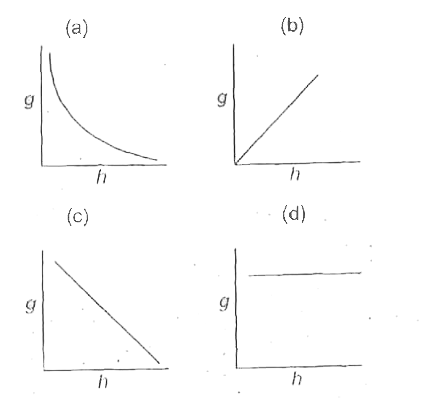Does the concentration of the earth's mass near its centre change the variation of g (acceleration due to gravity) with height from its surface?
To determine whether the concentration of the Earth's mass near its center affects the variation of acceleration due to gravity (g) with height from its surface, we can analyze the situation using the principles of gravitation.
1. Understanding the Concept of g:
The acceleration due to gravity (g) at a distance r from the center of the Earth is given by the formula:
g=GMr2
where G is the gravitational constant and M is the mass of the Earth.
2. Variation of g with Height:
As we move away from the surface of the Earth to a height h, the distance from the center of the Earth becomes:
r=R+h
where R is the radius of the Earth. Therefore, the expression for g at height h becomes:
gh=GM(R+h)2
3. Effect of Mass Distribution:
The question asks whether the concentration of mass near the center of the Earth affects g. According to the shell theorem, the gravitational effect of a spherical shell of uniform density is zero at any point inside the shell. Thus, for points outside the Earth, we can treat the Earth’s mass as if it were concentrated at its center.
4. Conclusion:
Since the formula for g at height h depends only on the total mass M of the Earth and the distance r from the center, and not on how that mass is distributed, we conclude that the concentration of the Earth's mass near its center does not affect the variation of g with height. Therefore, the variation of g with height remains unchanged regardless of mass distribution.
Final Answer:
No, the concentration of the Earth's mass near its center does not change the variation of g with height from its surface.
---
The acceleration due to gravity (g) at a distance r from the center of the Earth is given by the formula:
g=GMr2
where G is the gravitational constant and M is the mass of the Earth.
As we move away from the surface of the Earth to a height h, the distance from the center of the Earth becomes:
r=R+h
where R is the radius of the Earth. Therefore, the expression for g at height h becomes:
gh=GM(R+h)2
The question asks whether the concentration of mass near the center of the Earth affects g. According to the shell theorem, the gravitational effect of a spherical shell of uniform density is zero at any point inside the shell. Thus, for points outside the Earth, we can treat the Earth’s mass as if it were concentrated at its center.
Since the formula for g at height h depends only on the total mass M of the Earth and the distance r from the center, and not on how that mass is distributed, we conclude that the concentration of the Earth's mass near its center does not affect the variation of g with height. Therefore, the variation of g with height remains unchanged regardless of mass distribution.
No, the concentration of the Earth's mass near its center does not change the variation of g with height from its surface.
Topper's Solved these Questions
- GRAVITATIONBOOK - CENGAGE PHYSICS ENGLISHCHAPTER - GRAVITATIONEXERCISE - Exercise 6.3
16 Videos
- GRAVITATIONBOOK - CENGAGE PHYSICS ENGLISHCHAPTER - GRAVITATIONEXERCISE - Exercise 6.4
16 Videos
- GRAVITATIONBOOK - CENGAGE PHYSICS ENGLISHCHAPTER - GRAVITATIONEXERCISE - Exercise 6.1
13 Videos
- FLUID MECHANICSBOOK - CENGAGE PHYSICS ENGLISHCHAPTER - FLUID MECHANICSEXERCISE - INTEGER_TYPE
1 Videos
- KINEMATICS-1BOOK - CENGAGE PHYSICS ENGLISHCHAPTER - KINEMATICS-1EXERCISE - Integer
9 Videos
Similar Questions
Knowledge Check
If the radius of the earth were to shrink by 1%, its mass remaining the same, the acceleration due to gravity on the earth's surface would
Adecrease by 1%Bremain unchangedCincrease by 1%Dincrease by 2%
Which of the following graphs shows the variation of acceleration due to gravity g with depth h from the surface of the earth ?

View SolutionWhich graph correctley presents the variation of acceleration due to gravity with the distance form the centre of the earth?
View SolutionThe acceleration of a body due to the attraction of the earth (radius R) at a distance 2R form the surface of the earth is (g=acceleration due to gravity at the surface of the earth)
View SolutionIf the radius of the earth were to shrink by 1% its mass remaining the same, the acceleration due to gravity on the earth's surface would
View SolutionIf the radius of the earth were to shrink by one percent its mass remaining the same, the acceleration due to greavity on the earth's surface would
View SolutionThe period of a simple pendulum on the surface of the earth is 2s. Find its period on the surface of this moon, if the acceleration due to gravity on the moon is one-sixth that on the earth ?
View SolutionIf radius of the earth is 6347 km, then what will be difference between acceleration of free falls and acceleration due to gravity near the earth's surface?
View Solution
